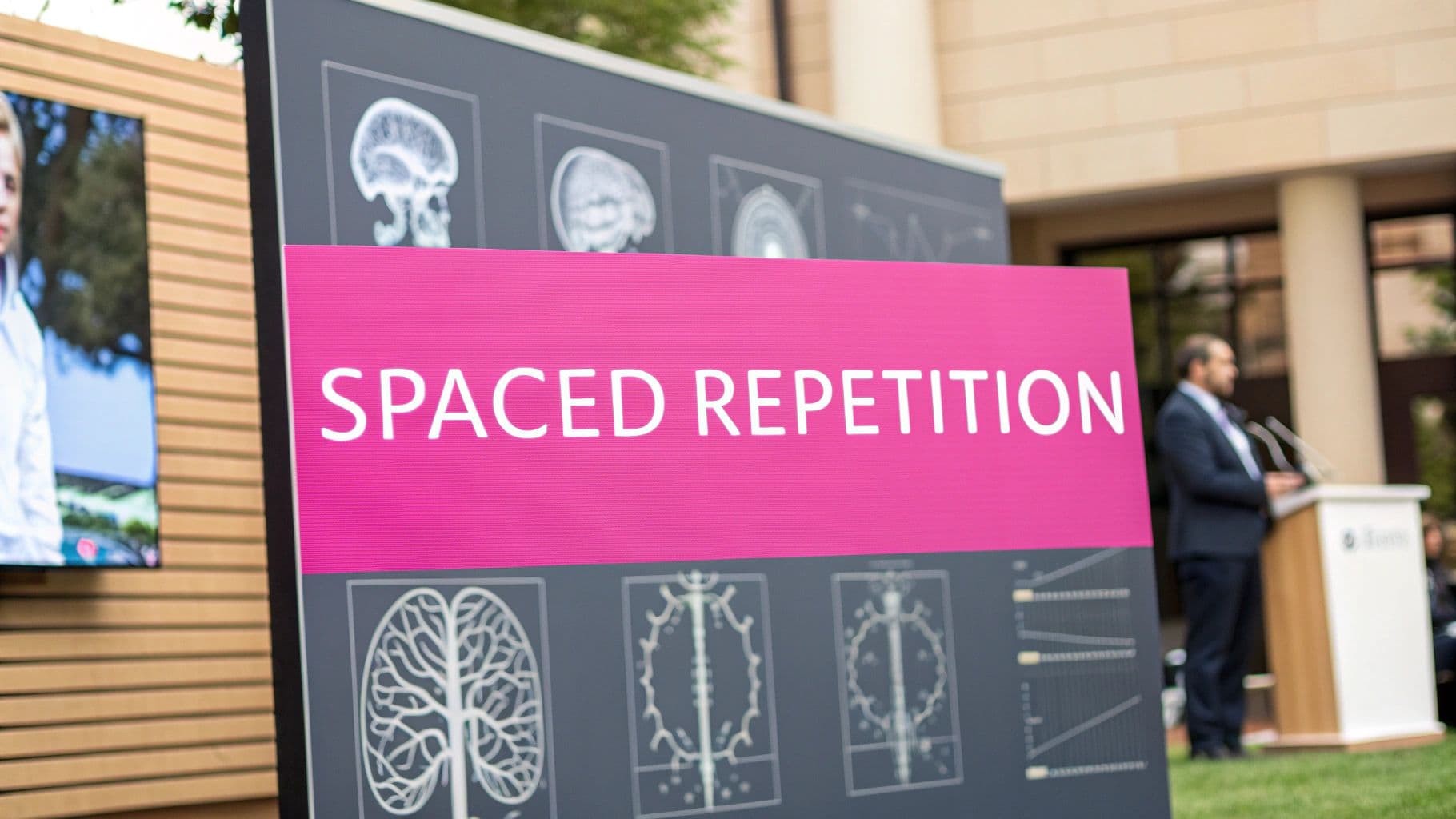
Master Your Learning with the Spaced Repetition Study Method: A Science-Backed Guide
Understanding the Science of Memory

Unlike computers with their orderly filing systems, our brains store memories through intricate electrochemical processes. When we learn something new, our neurons form connections called synapses that continuously reshape and strengthen with use. This is where spaced repetition becomes valuable – it works in harmony with our brain's natural memory-forming processes. Rather than cramming information that quickly fades from short-term memory, spaced repetition builds and reinforces these neural pathways over time for lasting retention.
Why Cramming Fails and Spaced Repetition Succeeds
Memory formation is similar to building muscle – a single intense workout won't create lasting strength. The same principle applies to learning – cramming information may help you pass tomorrow's test, but that knowledge typically vanishes soon after. For instance, research shows that students who cram tend to forget material within days of an exam since the information never moves beyond short-term storage.
In contrast, spaced repetition aligns with how our brains naturally process and store information. This approach, first documented by Hermann Ebbinghaus in the 1880s through his forgetting curve research, strategically times review sessions just before memories start to fade. Each review strengthens those neural connections, gradually transferring information from short-term to long-term memory storage. This creates durable learning that stands the test of time.
The Neurological Basis of Spaced Repetition
Brain imaging studies using EEG technology provide clear evidence for why spaced repetition works so well. These studies reveal increased activity in the right frontal brain regions during spaced learning sessions – areas specifically tied to memory formation and retention. This heightened neural activity shows that spaced repetition helps the brain better encode and stabilize new memories, making them easier to recall later. The biological evidence explains why this method consistently outperforms traditional study approaches.
Optimizing Your Learning with Spaced Repetition
Spaced repetition isn't just theory – it's a practical tool that delivers real results across many fields of study. Medical students use it to master complex anatomy, language learners apply it to build vocabulary, and research shows it can boost recall rates to 80% or higher compared to conventional study methods. The technique even improves performance on skill-based tasks like solving math problems. By understanding how memory works and applying spaced repetition principles, you can transform your approach to learning and achieve better, longer-lasting results.
Breaking Down the Method That Actually Works

Now that we understand how memory works and why cramming fails, let's examine how spaced repetition helps you learn and remember information more effectively. This approach isn't about studying for longer hours – it's about being strategic with your study time. By spacing out your review sessions at specific intervals, you strengthen your memory of the material each time you revisit it.
The Forgetting Curve and Its Implications
The science behind spaced repetition comes from the forgetting curve, discovered by Hermann Ebbinghaus in the 1880s. This curve shows that we lose information quickly right after learning it, but the rate of forgetting slows down over time. Spaced repetition works by reviewing material just before you're likely to forget it. For example, after learning new information, you might review it the next day, then three days later, then a week later. Each review session helps move that information into your long-term memory.
Optimal Review Intervals: Finding Your Rhythm
Success with spaced repetition depends on finding the right timing for your reviews. While everyone learns differently and material varies in difficulty, a good starting pattern is to review after one day, then after one week, and then after one month. As you get more comfortable with the material, you can stretch these intervals longer. This flexibility lets you spend more time on challenging concepts and less on material you already know well.
Why Timing Matters More Than Intensity
Research shows that short, frequent review sessions work better than marathon study sessions. Students who use spaced repetition typically remember 80% of what they learn, compared to 60% for those using traditional methods. This difference exists because spaced repetition works with your brain's natural learning processes. When you review information multiple times with breaks in between, you build stronger neural pathways for that knowledge.
Spaced Repetition: A Powerful Tool for Challenging Subjects
This method shines when you need to master subjects with lots of details or complex concepts. Medical students often use it to learn anatomy, while language learners rely on it to build vocabulary. The method also helps with practical skills like solving math problems. Its effectiveness comes from giving your brain time to process and integrate new information, whether you're memorizing facts or practicing problem-solving techniques.
Building Your Personal Review System

Making spaced repetition work requires more than just understanding the basic concepts. You need a well-organized system that fits your learning style and study materials. Let's explore how to create a personalized review system that turns spaced repetition from a theoretical idea into a practical daily habit.
Structuring Your Study Materials for Spaced Repetition
Good organization is essential before you start scheduling reviews. Think of this like organizing your kitchen – when everything has its proper place, cooking becomes much easier. The same applies to organizing your study materials.
- Create concise, focused flashcards: Break down complex topics into smaller, manageable pieces on individual flashcards. This helps you process the information more deeply as you summarize key points.
- Use different types of content: Mix text with images, diagrams, and audio clips in your flashcards. This engages multiple senses and makes the information stick better in your memory.
- Set up clear categories: Group your flashcards by subject, difficulty, or source material. This organization helps you target specific areas when reviewing and track your progress over time.
Crafting Your Personalized Review Schedule
With organized materials ready, it's time to plan your review timing. The key is working with your brain's natural forgetting patterns to strengthen memories at the right moments.
- Begin with frequent reviews: Review new information within 24-48 hours while it's fresh. Then gradually space out future reviews – try reviewing after a week, then a month as you gain confidence.
- Match frequency to difficulty: Spend more time reviewing challenging concepts compared to easier ones. For example, you might practice a tricky math formula daily at first, then reduce frequency as it becomes more familiar.
- Test yourself actively: Instead of just re-reading notes, quiz yourself first. Try recalling the information before checking the answer. This builds stronger memory pathways that help during tests and real application.
Integrating Spaced Repetition Into Your Daily Routine
The real power of spaced repetition comes from consistent practice. Here's how to make it a natural part of your schedule:
- Block out review time: Schedule specific review periods, even if just 15-20 minutes. Treat these like any other important commitment in your calendar.
- Use helpful tools: Take advantage of spaced repetition apps and software that can automate scheduling and progress tracking. Research shows digital flashcard systems can boost test scores by 10% compared to traditional study methods.
- Keep improving your system: Pay attention to what works best for you and adjust accordingly. Some people learn better with shorter, more frequent sessions while others prefer longer reviews less often. Fine-tune your approach based on your results and study preferences.
Leveraging Technology for Better Learning

The success of spaced repetition learning depends greatly on having effective tools to support the process. Digital technology offers many options that make it easier to maintain review schedules and monitor progress. Finding the right tools can significantly improve your learning experience and help you get better results.
Choosing the Right Spaced Repetition Software (SRS)
With so many SRS programs available, it helps to focus on the key features that matter most for effective learning:
- Flexible Scheduling: The software should let you adjust review intervals based on how quickly you learn and how challenging the material is. This personalization helps optimize the spacing of reviews.
- Multiple Content Formats: Look for software that supports text, images, audio, and video in your flashcards. Having different media types helps reinforce learning in multiple ways.
- Progress Tracking and Analytics: Good tracking tools show you how well you're retaining information and which areas need more work. This data helps you study more efficiently.
- Cross-Platform Accessibility: Being able to review on your computer, phone, or tablet means you can study whenever you have time. This flexibility makes it easier to maintain a consistent practice.
- User-Friendly Interface: The software should be simple and straightforward to use. When the interface is intuitive, you can focus on learning rather than figuring out how to use the program.
Creating Effective Digital Flashcards
To get the most benefit from spaced repetition, your digital flashcards need to be well-designed:
- Concise and Focused Content: Keep each flashcard focused on one specific concept or fact. For example, make separate cards for different aspects of the French Revolution instead of cramming everything onto one card.
- Active Recall Prompts: Write questions that make you think and retrieve information, rather than just reading passive statements. This deeper processing helps strengthen your memory.
- Multimedia Integration: Add relevant images, diagrams, and audio to make your cards more engaging and memorable. This is especially helpful for visual concepts or language learning.
Maximizing Your Technological Advantage
Here's how to make the most of your digital learning tools:
- Consistent Use: Study regularly with your SRS program, even if just for short sessions. Research shows that frequent brief reviews lead to better results than occasional long study sessions.
- Experiment and Adjust: Try different programs and approaches to find what works best for you. Pay attention to which methods help you learn most effectively and adjust accordingly.
- Integrate with Other Methods: Combine spaced repetition with techniques like active recall and the Feynman Technique. For instance, after creating a mind map of a new topic, make flashcards for key points to review over time. This combined approach helps both understand and remember the material.
Advanced Techniques for Optimal Results
Getting the most out of spaced repetition requires customizing the method to your needs. Beyond just following the basic principles, you'll want to refine your approach based on the specific content you're studying, your personal learning preferences, and how to stay motivated. Let's explore strategies to help you master this powerful study technique.
Customizing Intervals Based on Difficulty
Just like you wouldn't use the same workout routine for every muscle group, spaced repetition intervals should vary based on content difficulty. Take medical terminology as an example – a complex term like "electroencephalography" might need reviews after one day, two days, and then five days. But simpler terms like "cardiovascular" can handle longer initial intervals between reviews. By matching review frequency to difficulty level, you can concentrate your effort where it matters most while preventing unnecessary reviews of material you already know well.
Maintaining Motivation and Troubleshooting Obstacles
Even the best study system can feel challenging at times, especially with complex material. One effective approach is combining spaced repetition with complementary learning methods. After reviewing flashcards, try explaining concepts out loud as if teaching someone else – this reinforces understanding while adding variety. Breaking large topics into smaller, focused study sessions also helps prevent feeling overwhelmed. If certain material consistently gives you trouble, look for different explanations or visual aids that might help concepts click. Stay flexible and willing to adjust your approach when needed.
Tailoring Spaced Repetition to Different Learning Styles and Material
The beauty of spaced repetition is how easily it adapts to various learning preferences and subjects. Visual learners can add images and diagrams to their flashcards. Auditory learners benefit from recording and replaying key points during reviews. Those who learn by doing can write out concepts or use physical objects to reinforce learning. The method also works differently across subjects – language learning focuses on vocabulary and grammar, math requires practicing increasingly complex problems, while history benefits from reviewing timelines and concept maps at spaced intervals. Adapt the core technique to match your style and subject matter.
Tracking Progress and Refining Your System
Regular monitoring helps optimize your spaced repetition practice. Most study apps provide detailed analytics about recall accuracy and review patterns. Like a coach reviewing game footage, this data reveals your strengths and areas needing work, letting you adjust intervals and focus accordingly. Add periodic self-tests and practice quizzes to check overall understanding. This ongoing feedback loop helps you continuously improve your approach. With consistent analysis and refinement, you can keep enhancing your learning system to achieve better results.
Real Success Stories and Implementation
Learners worldwide have seen remarkable results by applying spaced repetition in their studies. These real experiences show how this method works in practice and offer valuable lessons for anyone looking to improve their learning.
From Medical School to Language Acquisition: Real-World Applications
Spaced repetition has proven effective across many different fields. Medical students studying complex anatomy terms have seen their test scores improve by up to 20% compared to classmates using traditional methods. Language learners also find great success with this approach – many report achieving fluency more quickly by reviewing vocabulary and grammar rules at carefully timed intervals. Their experiences show how the method adapts well to different types of learning material.
Overcoming Challenges and Achieving Sustainable Success
Getting started with spaced repetition isn't always easy at first. Students often struggle with staying consistent, finding time for reviews, and adapting the method to their learning style. But successful learners show these hurdles can be overcome. For instance, some have succeeded by reviewing flashcards during their daily commute using mobile apps, while others set aside dedicated study blocks. The key is finding an approach that fits your schedule and sticking with it.
Practical Insights From Successful Learners
People who have mastered spaced repetition share some key tips for success. They emphasize testing yourself before checking answers, as this active recall strengthens memory better than passive review. Many find it helpful to combine different learning formats – using images and audio along with text. Tracking progress through spaced repetition apps also helps optimize study schedules over time. Organization is crucial too – creating clear, focused flashcards and grouping related content makes reviews more effective.
Learning From Mistakes and Celebrating Victories
The path to success with spaced repetition isn't always smooth. Most learners face setbacks along the way. But these challenges provide valuable learning opportunities when viewed constructively. Analyzing what went wrong, adjusting study habits, and connecting with other learners helps refine the approach. Celebrating small wins is equally important for staying motivated. While spaced repetition requires patience and consistency, the experiences of successful learners show it can dramatically improve learning when applied thoughtfully over time.
Transform your study habits and unlock your learning potential with Notescast, the innovative app that turns your notes into engaging videos. Say goodbye to tedious reading and hello to addictive learning. Start your free trial today!
